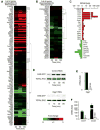Whole transcriptome analysis reveals an 8-oxoguanine DNA glycosylase-1-driven DNA repair-dependent gene expression linked to essential biological processes
- PMID: 25614460
- PMCID: PMC4359954
- DOI: 10.1016/j.freeradbiomed.2015.01.004
Whole transcriptome analysis reveals an 8-oxoguanine DNA glycosylase-1-driven DNA repair-dependent gene expression linked to essential biological processes
Abstract
Reactive oxygen species inflict oxidative modifications on various biological molecules, including DNA. One of the most abundant DNA base lesions, 8-oxo-7,8-dihydroguanine (8-oxoG) is repaired by 8-oxoguanine DNA glycosylase-1 (OGG1) during DNA base excision repair (OGG1-BER). 8-OxoG accumulation in DNA has been associated with various pathological and aging processes, although its role is unclear. The lack of OGG1-BER in Ogg1(-/-) mice resulted in decreased inflammatory responses and increased susceptibility to infections and metabolic disorders. Therefore, we proposed that OGG1 and/or 8-oxoG base may have a role in immune and homeostatic processes. To test our hypothesis, we challenged mouse lungs with OGG1-BER product 8-oxoG base and changes in gene expression were determined by RNA sequencing and data were analyzed by Gene Ontology and statistical tools. RNA-Seq analysis identified 1592 differentially expressed (≥ 3-fold change) transcripts. The upregulated mRNAs were related to biological processes, including homeostatic, immune-system, macrophage activation, regulation of liquid-surface tension, and response to stimulus. These processes were mediated by chemokines, cytokines, gonadotropin-releasing hormone receptor, integrin, and interleukin signaling pathways. Taken together, these findings point to a new paradigm showing that OGG1-BER plays a role in various biological processes that may benefit the host, but when in excess could be implicated in disease and/or aging processes.
Keywords: 8-Oxoguanine; Biological processes; Gene expression; OGG1-BER.
Copyright © 2015 Elsevier Inc. All rights reserved.
Figures





References
-
- Kanvah S, Joseph J, Schuster GB, Barnett RN, Cleveland CL, Landman U. Oxidation of DNA: damage to nucleobases. Acc Chem Res. 2010;43:280–287. - PubMed
-
- Steenken S, Jovanovic S. How Easily Oxidizable Is DNA? One-Electron Reduction Potentials of Adenosine and Guanosine Radicals in Aqueous Solution. J Am Chem Soc. 1997;119:617–618.
-
- Mitra S, Hazra TK, Roy R, Ikeda S, Biswas T, Lock J, Boldogh I, Izumi T. Complexities of DNA base excision repair in mammalian cells. Mol Cells. 1997;7:305–312. - PubMed
Publication types
MeSH terms
Substances
Grants and funding
LinkOut - more resources
Full Text Sources
Other Literature Sources
Medical
Molecular Biology Databases
Research Materials

